Grizzly bears are not typically hunters. Instead, they like to scavenge or forage for their meals most of the time. However, they are terrifying beasts when they do decide to attack prey. They can take down very large animals, including some moose. Yet, we have to wonder how they would take on extra-large fauna, like the extinct Irish elk. Today, we’re going to show you a grizzly bear vs Irish elk battle and prove which creature has the best chance of winning the battle.
Comparing a Grizzly Bear and an Irish Elk
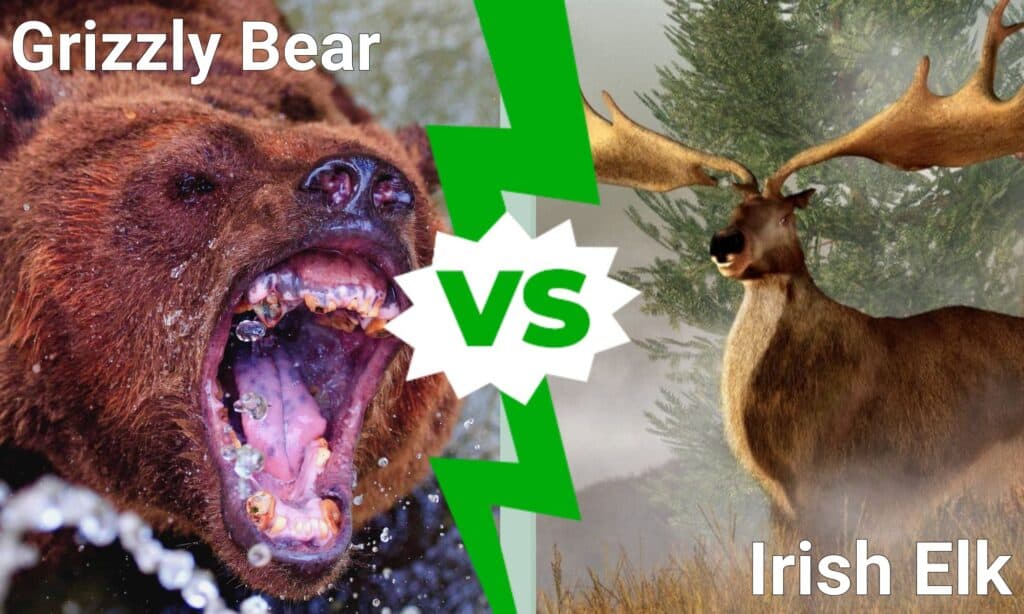
| Grizzly Bear | Irish Elk | |
|---|---|---|
| Size | Weight: typically weigh between 400 to 700 pounds, upwards of 1,000 to 1,200 at their largest Height: usually stand between 3 and 4 feet at the shoulder, up to 4.5 feet Length: grow between 7 and 10 feet at their longest | Weight: as much as 1,500 pounds or more Height: 6 feet 11 inches at the shoulder Length: between 9 and 10 feet 5 inches. |
| Speed | – Can run at speeds up to 35 mph | – Perhaps up to 50 mph, a rate that is like other similar animals |
| Defenses | – The bear’s speed lets it run from trouble – Thick layers of fur, skin, and fat absorb damage – The bear’s raw power makes it difficult to overwhelm | – Speed helps the elk escape most predators – Stamina allows it to run for long periods without exhaustion – Robust, powerful body would take damage |
| Offensive Capabilities | – Has claws between 3 and 5 inches in length that can slash prey – Has a bite power of 975 PSI along with 3-inch fangs and 1-inch teeth – Strong bite can be used to attack the vertebrate and skulls of prey – Shaking attacks disorient and cause significant harm to prey – Paw strikes cause significant damage | – Powerful legs could deliver a remarkably powerful kick – Had a set of massive antlers that measured 12 feet wide and weighed up to 88 pounds – Antlers could knock animals over or impale them causing fatal damage |
| Predatory Behavior | – Mostly opportunists that may track down and kill prey after pursuing them – Usually, they scavenge or gather their meals | – No predatory instincts |
What Are The Key Differences Between a Grizzly Bear and an Irish Elk?
The most significant differences between a grizzly bear and an Irish elk are found in their size and predation styles. A grizzly bear is an opportunistic, somewhat cursorial predator that weighs between 400 and 700 pounds on average, but they can get as heavy as 1,000 to 1,200 pounds while standing 3 to 4 feet and growing between 7 and 10 feet at their longest. Meanwhile, Irish elk were herbivores that weighed north of 1,500 pounds and stood about 7 feet tall.
These massive differences between the creatures make them unique, and they will impact the fight. We need more information before determining which of them is most likely to win.
What Are the Key Factors in a Fight Between a Grizzly Bear and an Irish Elk?
The most significant factors in a battle between a grizzly bear and an elk are their size, speed, defenses, and attack methods. We are going to explore each of these facets in depth, showing you which creature has an advantage over the other. By the time we’ve finished, you’ll have a very good idea of which animal is going to win.
Grizzly Bear vs. Irish Elk: Size

The Irish elk is larger than the grizzly bear.
©Daniel Eskridge/Shutterstock.com
An Irish elk is larger than a grizzly bear. The average Irish elk is believed to have weighed as much as 1,500 pounds, stood up to 7 feet tall at the shoulders, and grown up to 10 feet 6 inches long. They also had a rack of antlers that measures up to 12 feet wide.
Meanwhile, a grizzly bear averages about 400 to 700 pounds in weight, 7 to 10 pounds in length, and 3 to 4.5 feet in height at the shoulder. However, they can weigh over 1,000 pounds, up to 1,200 pounds. However, those sizes are very rare according to modern measures.
Irish elk have a size advantage over grizzly bears.
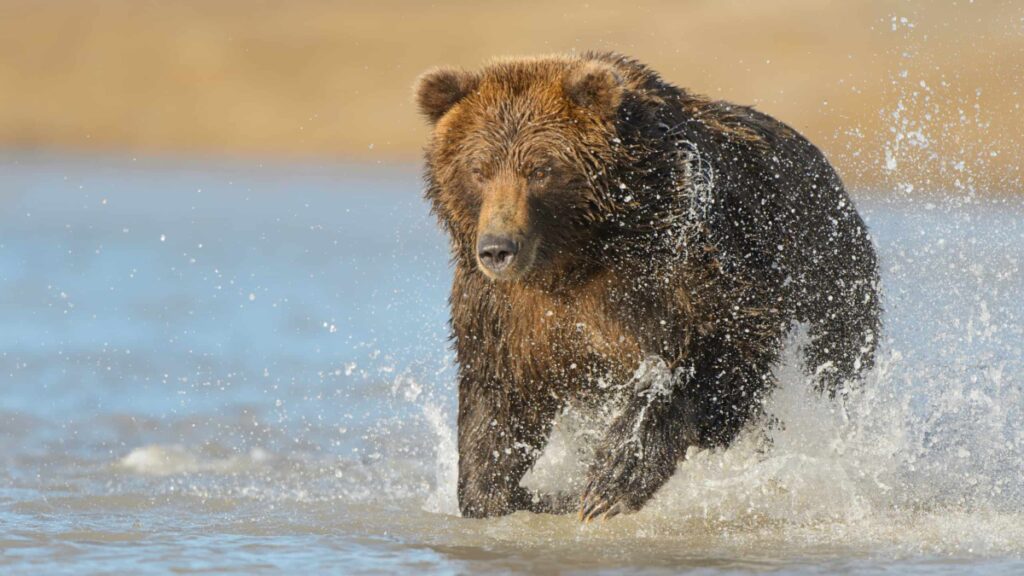
Grizzly bears can run at speeds up to 35 mph.
©NaturesMomentsuk/Shutterstock.com
Grizzly Bear vs. Irish Elk: Speed
Irish elk were, surprisingly, faster than grizzly bears. Both animals are rather swift, though. A grizzly bear can run at speeds of up to 35 mph. Moreover, Irish elk can run at speeds of 50 mph. At least, that’s the estimated top speed for these creatures.
Irish elk are faster than grizzly bears.
Grizzly Bear vs. Irish Elk: Defenses
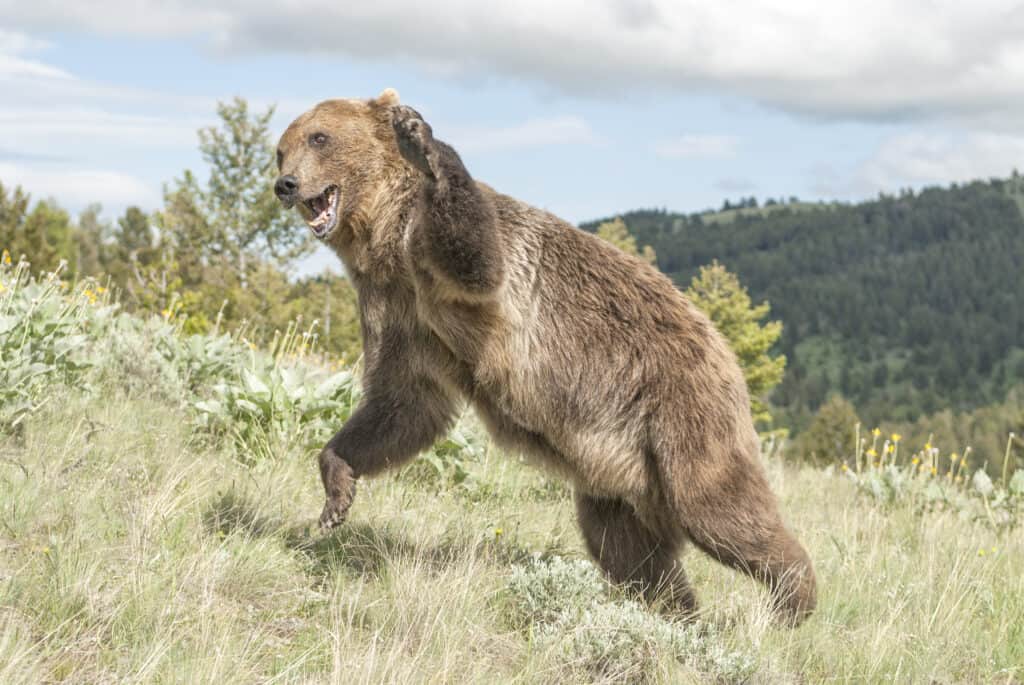
Grizzly bears have great physical defenses.
©outdoorsman/Shutterstock.com
Irish elk had a fair number of defenses. They had large bodies that were powerfully built. Moreover, they have the speed required to outrun a lot of predators. Not only could they run at speeds of up to 50 mph, but they could also keep that speed for up to 15 minutes.
Meanwhile, grizzly bears are thickly built, powerful creatures that would be hard to bring down for the count. They have great physical defenses including a layer of fat that can be several inches thick under their thick hides. Grizzlies are also very fast, and they can usually outpace other animals in their range.
Grizzly bears have a defensive advantage over Irish Elks.
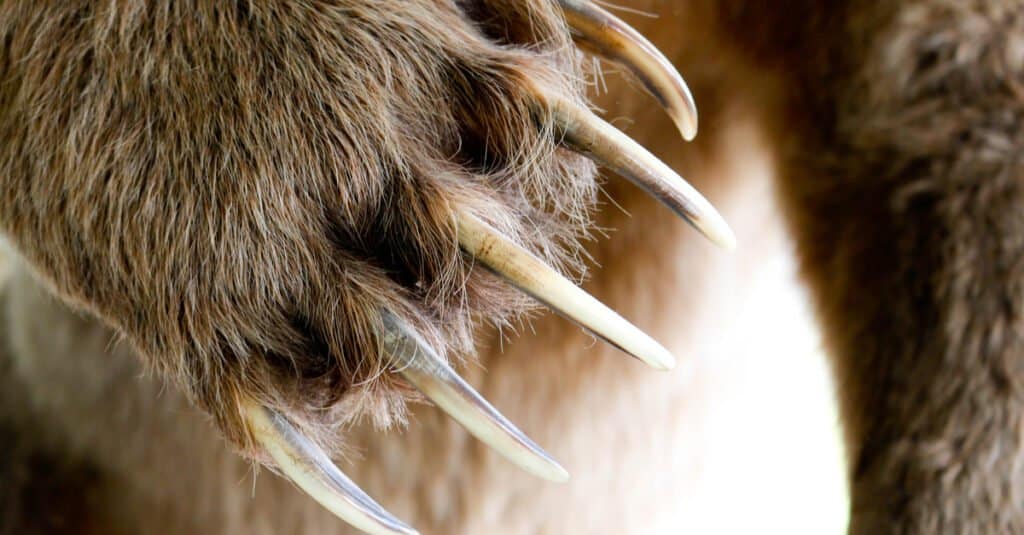
Grizzly bear paws have incredibly long claws up to 5 inches in length.
©TheWonderWays/Shutterstock.com
Grizzly Bear vs. Irish Elk: Offensive Capabilities
Irish elk did not have much in the way of offensive capabilities. Yet, they could fend off some animals. They had antlers that measured about 12 feet across, making them capable of ramming into and knocking down other animals. Meanwhile, Irish elk could also deliver a very powerful kick strong enough to kill pursuers.
Meanwhile, grizzly bears have a variety of different weapons that they can use to kill prey. For one thing, they have a powerful bite, capable of delivering 975 PSI. Moreover, they have claws that measure between 3 and 5 inches in length that they can use to slash prey. They also use their massive paws to beat prey into submission. The combined mauling attack delivered by this bear integrates horrific bites to the back and neck, smacks, pinning, and clawing to kill their prey.
Grizzly bears have an advantage in offensive capabilities.
Grizzly Bear vs Irish Elk: Predatory Behavior
The Irish elk had no predatory behaviors. They were herbivores. Meanwhile, grizzly bears are more like part-time predators. They scavenge for meals or gather them. These bears are opportunists at heart, though. They track down prey when they can, chase them down, and kill them with a vicious assault.
Grizzly bears have an advantage in predatory behaviors.
Who Would Win in a Fight Between a Grizzly Bear and an Irish Elk?
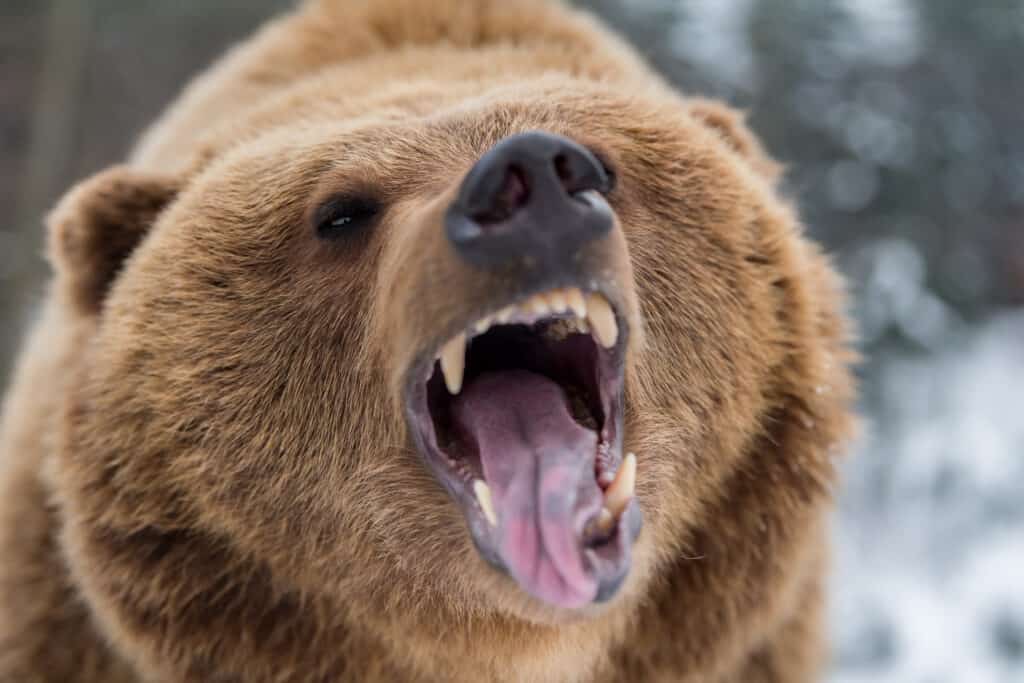
A Grizzly bear would win a fight against an Irish elk.
©Volodymyr Burdiak/Shutterstock.com
A grizzly bear would win a fight against an Irish elk. Irish elk are larger than grizzly bears. However, they don’t have killer instincts. They would not be the ones to instigate the fight, and that’s what would let the grizzly bear win. The grizzly would go after the Irish elk, and the latter would flee.
Grizzly bears kill adult moose and even bison in the present day because they are strong, aggressive animals and their prey are not.
If the Irish elk decided to make a stand against the grizzly bear, it could potentially impale the bear on its massive antlers. Moreover, it could land a kick against the grizzly bear or knock it out with a charge. Most of the time, the elk is going to flee and not fight, though.
The more likely outcome in this fight is that the grizzly chases down the Irish elk. The Irish elk had a speed and stamina advantage, but grizzly bears catch faster deer with some frequency.
Like other taller animals, the grizzly bear would go for the back, sides, and undersides of the Irish elk. It would sap the elk’s strength, bring it to the ground, and tear it apart. A wayward kick or non-fatal stabbing by the antlers would not slow down the grizzly’s assault, but it would continue attacking until the fight has ended.
The photo featured at the top of this post is © Volodymyr Burdiak/Shutterstock.com
Thank you for reading! Have some feedback for us? Contact the AZ Animals editorial team.






